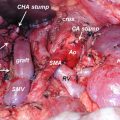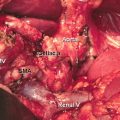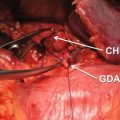© Springer-Verlag Berlin Heidelberg 2017
Sun-Whe Kim and Hiroki Yamaue (eds.)Pancreatic Cancer10.1007/978-3-662-47181-4_1414. The History and Evolution of Pancreaticoduodenectomy
(1)
Department of Surgery, Johns Hopkins University School of Medicine, Baltimore, MD 21287, USA
14.1 Introduction
Pancreaticoduodenectomy (PD) is the procedure of choice for periampullary cancers, which include four separate malignancies occurring in the region of the ampulla of Vater: pancreatic ductal adenocarcinoma (PDAC), ampullary cancer, distal cholangiocarcinoma, and duodenal adenocarcinoma. The evolution of PD began as a series of isolated, independent resection attempts in the late 19th and early 20th centuries, but the procedure failed to gain momentum because of its great technical difficulty and dismal outcomes. Allen O. Whipple and colleagues were the first to adopt a systematic approach to radical pancreaticoduodenal resections and by 1935, they had demonstrated the technical feasibility of the procedure. However, the highly morbid operation was nearly abandoned altogether after postoperative outcomes failed to improve in the decades following Whipple’s initial success. Fortunately, a trend in centralization and standardization of care beginning in the 1980s fueled a decrease in perioperative mortality rates that now stands at 1-2% at high volume centers.
14.2 The Modern Surgical Era
Prior to the mid-nineteenth century, surgical expertise and scope was limited by two primary barriers. First, there were no effective means of anesthesia. Procedures had to be quick and relatively straightforward in order for patients to tolerate them. The other barrier was the extraordinarily high rate of surgical site infections. Infectious complications generated mortality rates exceeding 50% for patients undergoing amputations and abdominal procedures were almost uniformly fatal [1–3]. Together, these factors limited the majority of surgical procedures to amputations, lancing of boils, and resection of small subcutaneous lesions. Major surgeries were rare and generally reserved as the last resort for life-threatening conditions.
Change began in 1842 with the introduction of ether anesthesia by a rural Georgia surgeon named Crawford W. Long [4]. Although Dr. Long’s use of ether anesthesia was well known in the surgical circles of the Southern United States, he did not initially publish his findings. Instead, the technique was made famous independently by William T. G. Morton’s widely publicized demonstration at Massachusetts General Hospital in 1846 [5, 6]. The arrival of ether anesthesia eliminated the issue of human suffering and set the stage for longer, more complex procedures.
Infectious complications were more difficult to address because their causes were not well understood. Germ theory had not yet been widely accepted and surgeons rarely cleaned their instruments or hands between patients. Joseph Lister believed that infection resulted from wound contamination by airborne microorganisms and introduced the concept of surgical antisepsis in 1867 [7, 8]. This technique relied upon the application of carbolic acid to the wound during surgery and afterwards in wound dressings to kill any contaminating microorganisms. By the early twentieth century, Listerian antisepsis had evolved into early modern aseptic technique, which was responsible for a dramatic decrease in postoperative mortality. In one report from 1895, the introduction of antisepsis and eventually asepsis at the University Hospital in Munich led to a reduction amputation-associated mortality from greater than 60% to just 2% [2].
14.3 The First Pancreatic Resections
The earliest pancreatic resections involved the tail of the pancreas since it was more easily accessible and amenable to resection without the need for complicated reconstructions. Friedrich Trendelenburg (1824–1924), professor of surgery at the University of Bonn, is credited with the first distal pancreatectomy in 1882 for a massive spindle cell carcinoma in the tail of the pancreas [9]. The procedure lasted and hour and a half and was complicated by an injury to the spleen requiring splenectomy. The patient suffered a complicated postoperative course and died shortly after discharge, but details regarding the exact cause of death are unclear.
Resections in the head of the pancreas were approached with more caution due to its intimate association with the confluence of the biliary, pancreatic, and gastrointestinal systems and its proximity to major vascular structures. The Italian surgeons Giuseppe Ruggi and Domenico Biondi made the first attempts at pancreatic head resection in 1889 and 1894, respectively. Ruggi enucleated a large pancreatic head mass that did not involve the ductal system or require a reconstructive procedure. Biondi’s procedure was more extensive and essentially constituted a duodenum-sparing pancreatic head resection for a fibroadenoma. This was the first procedure to involve transection of the pancreatic duct and was followed by reapproximation of the pancreatic remnant to the duodenum.
14.4 Early Attempts at Pancreaticoduodenectomy
The first PD was performed in 1898 by Alessandro Codivilla (1861–1912), an Italian surgeon best known for his contributions to the field of orthopedic surgery [10]. Prior to his appointment as a professor of orthopedic surgery, Codivilla was a skilled abdominal surgeon with considerable expertise in gastric procedures. His patient was a 46-year-old gentleman who presented with several days of abdominal distension and vomiting. Upon exploration, the patient was found to have a large pancreatic tumor involving the duodenum and stomach and was not amenable to a limited resection. Instead, Codivilla performed an ambitious en bloc resection of the pancreatic head, proximal duodenum, distal stomach, and distal common bile duct. His reconstruction consisted of a Roux-en-Y gastrojejunostomy with cholecystojejunostomy over Murphy buttons. He is presumed to have ligated and oversewn the pancreatic remnant, but this is not explicitly stated in his operative report. Unfortunately, the patient developed complications consistent with a pancreatic fistula and died in the early postoperative period [10, 11].
William Stewart Halsted (1852–1922) performed the first successful ampullary resection at the Johns Hopkins Hospital just 5 days after Codivilla’s PD [12]. He accessed the ampulla through a transduodenal incision and resected the tumor with generous margins that included segments of the pancreatic and common bile ducts. Using silk sutures, he restored biliopancreatic outflow by reimplanting the ducts into the primary duodenal closure. The procedure was a technical success, but the patient ultimately died the following year after her cancer recurred.
The first successful PD was performed for ampullary cancer in 1909 by the German surgeon Walther Kausch (1867–1928). He divided the procedure into two stages, the first of which was designed to relieve the patient’s severe jaundice through a loop cholecystojejunostomy and Braun anastomosis. In the second stage, he resected most of the duodenum en bloc with a small portion of the pancreatic head, followed by gastrojejunostomy (GJ) and end-to-end pancreaticojejunostomy (PJ). Despite Kausch’s success, he never performed another PD and only a few more attempts are documented in the literature over the next two decades. Among these was the first successful one-stage PD by Georg Hirschel of Heidelberg in 1912, which was notable for the use of rubber tubing to reconstruct the biliary tract. Another was the Italian surgeon Ottorino Tenani’s successful two-stage PD in 1918, which was the first to utilize blood transfusion and pancreatic enzyme supplementation.
14.5 The Whipple Era
Allen O. Whipple (1881–1963) is the father of pancreatic surgery in North America and namesake of pancreaticoduodenectomy. Although he was not the first surgeon to attempt PD, the Whipple procedure is aptly named because he was the first to systematically optimize it enough for clinical relevance, the first to recognize the importance of a truly radical resection, and the first to mobilize the surgical community at large into concerted action.
Whipple was surgeon-in-chief and Valentine Mott Professor of Surgery at Columbia Presbyterian Medical Center in New York when he began tackling the problem of periampullary cancer. He believed that the transduodenal approach in use at the time carried too much surgical risk without offering a sufficient oncologic benefit; patients either died from surgical complications or survived to see their disease rapidly recur [13]. However, Whipple was inspired by recent advances in pancreatic surgery including Roscoe Graham’s enucleation of an insulinoma in 1929 [14] and Evarts Graham’s subtotal pancreatectomy for hypoglycemia in 1934 [15]. These successes chipped away at the noli me tangere perception of the pancreas by demonstrating “that a large part of the pancreas [could] be safely excised” [13, 16]. In 1934, following a failed transduodenal resection attempt, Whipple began devoting his research efforts to developing a safer and more oncologically sound resection technique. Prior to Whipple, such procedures were rarely performed due to prohibitively high mortality rates. However, he persevered through setbacks and methodically improved his technique through a process of trial and error. From his writings, Whipple clearly understood the gravity of his undertaking and frequently referenced Kehr’s belief that “many failures would be necessary before the radical operation would prove successful” [16, 17].
14.5.1 Whipple’s Two-Stage Pancreaticoduodenectomy
In 1935, Whipple presented his landmark manuscript Treatment of Carcinoma of the Ampulla of Vater to the American Surgical Association [13]. In it, he described a two-stage technique for the radical resection of periampullary cancers that he developed over the course of management for three successive patients. The first was a 60-year-old woman with 10 weeks of painless progressive jaundice from an obstructing periampullary cancer. Like Kausch, Whipple favored a staged approach to address the biliary obstruction and its associated risks prior to definitive tumor resection. The first stage consisted of choledochoduodenostomy and cholecystostomy, followed by transduodenal en bloc resection of the ampullary region and a portion of the pancreatic head 7 weeks later. For reconstruction, Whipple used chromic catgut sutures to anastomose the pancreatic stump to the duodenal resection window. Although Halsted had already successfully performed a similar anastomosis using silk sutures [12], Whipple and his contemporaries preferred catgut because they considered the duodenum a contaminated field. Unfortunately, Whipple failed to account for the presence of activated pancreatic “ferments,” which rapidly digested the absorbable sutures. The pancreatic anastomosis subsequently dehisced and the patient died of diffuse peritonitis within 30 hours of the procedure.
Whipple initially opted for transduodenal excision because of the prevailing belief that the duodenum and exocrine pancreatic function were necessary for life. However, based on his experience with his first patient, he decided that transduodenal excision did not allow for wide enough margins and was “at best . . . an inadequate attempt at cancer surgery” [16]. Furthermore, he decided that the pancreatic anastomosis should be avoided since re-establishing pancreatic outflow led directly to activation of pancreatic secretions (through interaction with intraluminal contents) and inherently endangered such an anastomosis. Undeterred, Whipple envisioned a more radical resection based on animal studies demonstrating survival following total duodenectomy [18–20] and pancreatic duct [21–23]. For his second attempt in a 53-year-old man with periampullary cancer, he excised en bloc a full segment of duodenum with the ampulla and head of the pancreas followed by end-to-end duodenoduodenostomy and pancreatic stump exclusion. He made use of other lessons from his earlier experience as well by replacing catgut sutures with more durable fine silk and revising the biliary bypass to a cholecystgastrostomy to minimize interference with the definitive resection to follow. Unfortunately, the patient developed an anastomotic stricture and required a gastrojejunostomy to bypass his duodenoduodenostomy. Despite recovering well from this, he ultimately died 8 months after the original procedure due to cholangitis. Subsequent autopsy revealed that he had developed critical stenosis of his cholecystgastrostomy, but notably showed no evidence of recurrent disease.
The second patient was further evidence for Whipple that the duodenum was nonessential to life. For the third patient, a 49-year-old man with periampullary cancer, Whipple performed the first recorded total duodenectomy in man en bloc with a wedge-shaped portion of the pancreatic head. Gastrointestinal continuity was maintained through a gastrojejunostomy constructed preemptively during the first stage, and the pancreatic stump was again excluded. This procedure was considered a success overall, and the patient lived another 25 months before succumbing to metastatic disease.
Whipple made just one more significant modification to his two-stage procedure by revising the biliary bypass to a Roux-en-Y cholecystojejunostomy to address the issue of recurrent cholangitis. His report to the American Surgical Association reignited interest in the surgical management of periampullary cancers and soon an entire community of pioneering surgeons had emerged. In 1937, Alexander Brunschwig extended the indications for PD by performing the first successful radical resection of a pancreatic cancer [24].
14.5.2 Whipple’s One-Stage Pancreaticoduodenectomy
Transition to a one-stage radical resection occurred quite by chance on March 6, 1940. While operating on 53-year-old woman with presumed gastric cancer, Whipple transected the midportion of the stomach and was “astonished and chagrined” to find that the tumor was actually located in the head of the pancreas [17]. Since the patient was not jaundiced, he proceeded with conversion to an improvised PD by extending the usual en bloc resection to include the distal stomach along with the duodenum and head of the pancreas. For the reconstruction, he performed an antecolic loop gastrojejunostomy and introduced the choledochojejunostomy instead of using the gallbladder for the biliary anastomosis [25, 26]. Pathology revealed a nonfunctioning islet cell carcinoma, and the patient lived an additional 9 years before dying of metastatic disease. Shortly thereafter, successful one-stage pancreaticoduodenectomies were independently performed by Verne Hunt [27] in Los Angeles and Ridgway Trimble [28] in Baltimore as well.
Whipple’s one-stage procedure was serendipitously timed because vitamin K had just become clinically available within the past year [25]. Vitamin K’s ability to correct the coagulopathy associated with prolonged biliary obstruction eliminated much of the surgical risk driving the need for a staged procedure. Thereafter, Whipple recommended the one-stage technique as the procedure of choice because it avoided the increased risk associated with two operations.
Although Whipple initially condemned attempts at pancreatic anastomoses, he continued to struggle with complications from pancreatic fistulae despite his method of pancreatic exclusion. In 1941, Hunt [27] reported a successful pancreaticojejunostomy during a radical two-stage PD and was soon joined by several other surgeons in adopting the pancreatic anastomosis [29, 30]. By 1942, Whipple had also incorporated pancreaticojejunostomy into his technique, which at the time consisted of the following:
At least two days of vitamin K and bile salts therapy; 2) the distal half of the stomach, the entire duodenum, the terminal portion of the common duct and the head of the pancreas were removed en masse; 3) a vertical limb of the jejunum, starting at the duodenojejunal junction, was brought up through a rent in the mesocolon, behind the colon, with the following anastomoses in sequence: a) a choledochojejunostomy, end-to-end; b) an anastomosis between the pancreatic duct and the wall of the jejunal opening the size of the pancreatic duct, followed by the tacking of the stump of the resected pancreas to the wall of the jejunum; c) an end-to-side gastrojejunostomy. A sum drain in the bed of the duodenum was used. Silk technic was employed throughout [17]
14.6 Evolution After Whipple
Whipple’s one-stage procedure remained the gold standard for resection over the next several decades. Although many variations were reported over the years, already at least 68 by 1956 [31], these generally consisted of minor changes to one or more of the anastomoses with preservation of the overall structure and principles pioneered by Whipple.
Stay updated, free articles. Join our Telegram channel

Full access? Get Clinical Tree






